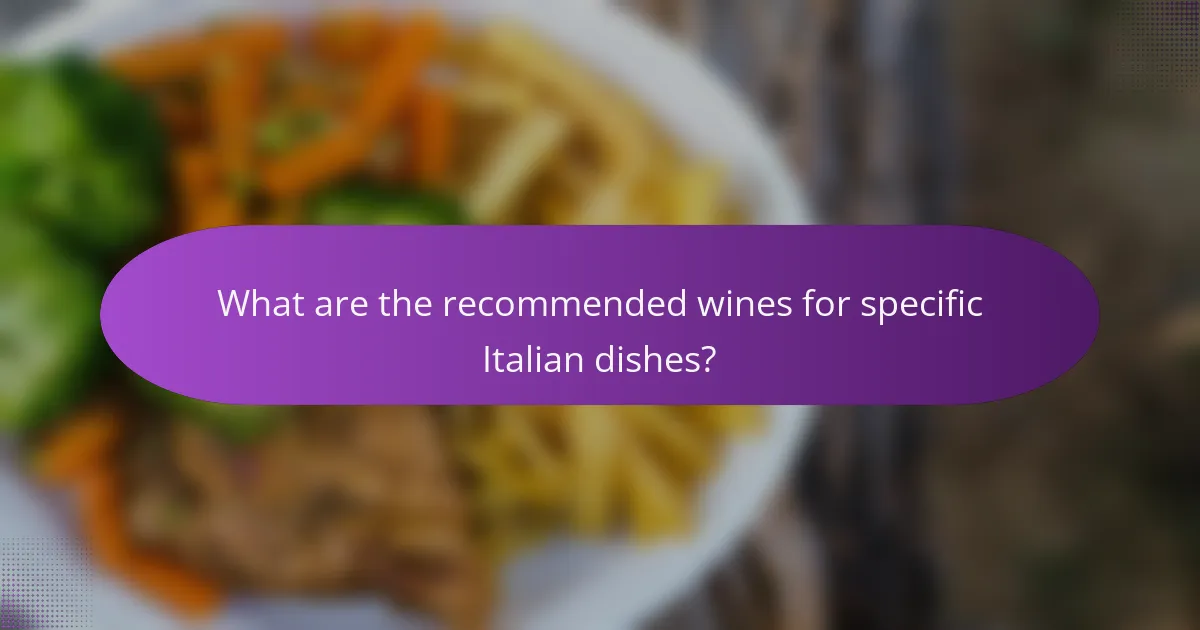
What is Wine Pairing with Italian Dishes?
Wine pairing with Italian dishes involves selecting wines that enhance the flavors of the food. Italian cuisine features a variety of ingredients, including tomatoes, cheese, and herbs. Each dish has specific wine recommendations based on its flavor profile. For example, a rich tomato sauce pairs well with Chianti, while creamy Alfredo dishes complement Chardonnay. The acidity in wines can balance the richness of certain Italian meals. Additionally, local Italian wines often reflect regional dishes, enhancing authenticity. Research indicates that proper wine pairing can elevate the dining experience significantly.
How does wine pairing enhance the dining experience?
Wine pairing enhances the dining experience by complementing the flavors of food. It creates a harmonious balance between the dish and the wine. This balance can elevate the overall taste perception. For example, acidic wines can cut through rich, fatty dishes. This interaction can enhance the flavors of both the food and the wine. Studies show that proper pairing can improve enjoyment and satisfaction. Research indicates that consumers rate meals with matched wines higher than those without. Therefore, wine pairing is essential for a refined dining experience.
What are the fundamental principles of wine pairing?
The fundamental principles of wine pairing are based on balancing flavors, textures, and acidity. Matching the body of the wine with the weight of the food enhances the dining experience. Complementing flavors between the wine and dish creates harmony on the palate. Contrasting elements can also work, such as pairing rich foods with acidic wines to cut through fat. Regional pairing is a common practice, where local wines complement local dishes. For instance, Italian wines typically pair well with Italian cuisine. Understanding tannins and how they interact with proteins is crucial. Tannins in red wines can soften when paired with fatty meats.
How does flavor profile influence wine selection?
Flavor profile significantly influences wine selection by determining complementary tastes. Wines with fruity profiles pair well with dishes that have similar flavors. For example, a wine with berry notes enhances a tomato-based pasta. Conversely, wines with earthy tones complement mushroom dishes effectively. The acidity in wine also balances the richness of creamy sauces. A high-acid wine cuts through fat, making it ideal for rich Italian dishes. Research shows that matching flavor profiles enhances the overall dining experience. According to a study by the American Journal of Enology and Viticulture, proper pairings can elevate the perception of both food and wine.
What types of Italian dishes are commonly served in Canadian restaurants?
Common Italian dishes served in Canadian restaurants include pasta, pizza, and risotto. Pasta dishes often feature varieties like spaghetti, fettuccine, and penne. Popular sauces include marinara, Alfredo, and pesto. Pizza is typically made with thin crust or thick crust and topped with ingredients like pepperoni, mushrooms, and bell peppers. Risotto is a creamy rice dish often cooked with broth and flavored with ingredients such as mushrooms or seafood. These dishes reflect traditional Italian cuisine and are widely enjoyed across Canada.
How do regional Italian cuisines differ in terms of wine pairing?
Regional Italian cuisines differ significantly in wine pairing due to local ingredients and traditions. For example, Northern Italian dishes often feature rich, creamy sauces and pair well with white wines like Pinot Grigio. In contrast, Southern Italian cuisines, characterized by tomato-based sauces, typically complement red wines like Nero d’Avola.
Tuscany, known for its hearty meat dishes, pairs excellently with Chianti, while the seafood-rich cuisine of the coastal regions favors lighter whites like Vermentino. Each region’s climate and agricultural practices influence the types of wines produced, further shaping their pairing choices.
Historical practices also play a role. For centuries, locals have matched specific wines with regional dishes, creating a deep-rooted tradition of pairing. This cultural heritage ensures that wine selections enhance the unique flavors of local cuisines.
What are the most popular Italian dishes in Canadian Italian restaurants?
The most popular Italian dishes in Canadian Italian restaurants include pasta, pizza, and risotto. Pasta dishes like spaghetti carbonara and fettuccine alfredo are frequently ordered. Pizza, especially Margherita and pepperoni, is a staple on menus. Risotto, particularly mushroom risotto, is also well-liked. Other popular choices include lasagna and tiramisu for dessert. These dishes reflect traditional Italian cuisine and are adapted to local tastes. The popularity of these dishes is supported by their presence in numerous restaurant menus across Canada.
What are the key factors to consider for wine pairing with Italian dishes?
The key factors to consider for wine pairing with Italian dishes include the dish’s flavor profile, acidity, and body. Italian cuisine often features rich sauces, herbs, and spices. These elements influence the choice of wine. For example, tomato-based sauces pair well with acidic wines like Chianti. Creamy dishes benefit from fuller-bodied wines such as Chardonnay. Additionally, consider regional pairings; wines from the same region as the dish often complement flavors harmoniously. Lastly, personal preference plays a significant role in wine selection.
How do acidity and tannins affect wine choices?
Acidity and tannins significantly influence wine choices. Acidity provides freshness and balance, making wines more food-friendly. High-acid wines pair well with rich Italian dishes, cutting through fat and enhancing flavors. Tannins contribute structure and astringency, affecting the perception of wine with food. Wines with high tannins can soften when paired with protein-rich dishes, such as red meats. For instance, a Chianti, which has both acidity and tannins, complements tomato-based sauces commonly found in Italian cuisine. Selecting wines with the right balance of acidity and tannins enhances the overall dining experience.
What role does body and sweetness play in pairing wines?
Body and sweetness significantly influence wine pairing. The body of a wine refers to its weight and texture in the mouth, which can be light, medium, or full. A wine’s body should complement the richness of the food. For instance, full-bodied wines pair well with hearty dishes. Sweetness in wine balances flavors and can enhance or contrast with food. Sweet wines can offset spicy or acidic dishes, creating harmony. For example, a sweet Riesling can complement spicy Italian dishes. Together, body and sweetness help achieve a balanced and enjoyable dining experience.

What are the recommended wines for specific Italian dishes?
Chianti is recommended for pasta with tomato sauce. This wine’s acidity complements the acidity in tomatoes. Pinot Grigio pairs well with seafood dishes. Its crispness enhances the flavors of fish and shellfish. For creamy sauces, a Chardonnay is ideal. Its richness balances the creaminess of the dish. Barolo is perfect for red meat dishes. This full-bodied wine enhances the flavors of beef and lamb. Prosecco is suggested for light appetizers. Its bubbles and sweetness complement antipasti and light fare. Lastly, a dessert wine like Vin Santo is ideal with biscotti. This pairing enhances the sweetness of the dessert.
Which wines pair best with pasta dishes?
Red wines such as Chianti and Barbera pair best with pasta dishes. These wines complement tomato-based sauces commonly found in pasta. Chianti, with its high acidity, enhances the flavors of marinara sauce. Barbera, known for its fruitiness, balances rich meat sauces. White wines like Pinot Grigio and Sauvignon Blanc also work well. They are excellent with lighter pasta dishes, especially those with cream or seafood. Pinot Grigio offers a crisp finish that refreshes the palate. Sauvignon Blanc’s herbal notes enhance vegetable-based pasta.
What are the ideal wine choices for tomato-based sauces?
The ideal wine choices for tomato-based sauces include Chianti, Sangiovese, and Barbera. Chianti is a classic Tuscan wine that complements the acidity of tomato sauces. Sangiovese, the primary grape in Chianti, offers bright cherry flavors that enhance the dish. Barbera, with its low tannins and high acidity, balances the richness of the sauce. These wines typically have fruity profiles that harmonize with the tomatoes. Additionally, their acidity cuts through the sauce’s richness, creating a well-rounded pairing.
How do cream-based sauces influence wine selection?
Cream-based sauces typically call for wines that can complement their rich and creamy texture. White wines, particularly those with good acidity, are often preferred. Varietals like Chardonnay or Sauvignon Blanc balance the creaminess without overpowering the dish.
The acidity in these wines cuts through the fat, enhancing the overall flavor experience. For instance, a buttery Chardonnay pairs well with fettuccine Alfredo. Alternatively, a light Pinot Grigio can complement a creamy mushroom sauce.
Research supports that acidity in wine enhances the perception of creaminess in dishes. This pairing principle is crucial for creating a harmonious dining experience.
What wines complement popular Italian appetizers?
White wines such as Pinot Grigio and Sauvignon Blanc complement popular Italian appetizers. These wines pair well with light dishes like bruschetta and caprese salad. Their acidity balances the flavors of tomatoes and fresh mozzarella. For richer appetizers like arancini, a medium-bodied Chardonnay enhances the experience. Red wines like Chianti pair excellently with cured meats and antipasto platters. The tannins in Chianti complement the saltiness of the meats. Prosecco is ideal for fried appetizers, as its bubbles cleanse the palate. Each wine choice enhances the overall dining experience with Italian cuisine.
Which wines enhance the flavors of antipasti?
White wines like Pinot Grigio and Sauvignon Blanc enhance the flavors of antipasti. These wines have crisp acidity that complements the variety of flavors in antipasti. The light body of Pinot Grigio pairs well with vegetables and seafood. Sauvignon Blanc adds a zesty touch that balances salty cured meats. Red wines like Chianti also work well with antipasti. Chianti’s fruity notes and acidity match well with cheeses and olives. Prosecco is another excellent choice, offering a refreshing effervescence that cleanses the palate. These pairings are based on traditional Italian dining practices that emphasize harmony between food and wine.
What are the best wine options for bruschetta?
The best wine options for bruschetta include Sauvignon Blanc and Chianti. Sauvignon Blanc complements the fresh toppings often found on bruschetta. Its acidity balances the richness of ingredients like olive oil and cheese. Chianti, a classic Italian red, enhances the flavors of tomato and basil. The wine’s tannins work well with the savory aspects of bruschetta. Both wines are versatile choices that elevate the dining experience.
How do dessert wines pair with Italian desserts?
Dessert wines complement Italian desserts by enhancing their flavors and balancing sweetness. The rich, fruity profiles of dessert wines like Vin Santo or Moscato align well with the creamy textures of desserts such as tiramisu or panna cotta. The acidity in these wines cuts through the richness, providing a refreshing contrast. For example, a sweet Prosecco pairs beautifully with fruit-based desserts like panna cotta topped with berries. Additionally, the aromatic qualities of dessert wines elevate the overall tasting experience. This pairing tradition is rooted in Italian culinary practices, where the harmony of flavors is paramount.
What wines are best for pairing with tiramisu?
Dessert wines are best for pairing with tiramisu. Specifically, sweet wines like Vin Santo or Moscato complement the coffee and cocoa flavors. These wines enhance the dessert’s richness without overpowering it. Additionally, a light-bodied red like Pinot Noir can also work well. The fruitiness of Pinot Noir balances the creaminess of tiramisu. The sweetness of dessert wines typically ranges from 5% to 20% residual sugar, making them ideal for desserts. This pairing tradition is well established in Italian cuisine, where dessert wines are often served with rich, creamy desserts.
How do sweet wines enhance the experience of panna cotta?
Sweet wines enhance the experience of panna cotta by complementing its creamy texture and subtle flavors. The sweetness in the wine balances the dessert’s richness. This contrast creates a harmonious taste experience. For example, a Moscato or a late-harvest Riesling adds fruity notes that elevate the panna cotta’s vanilla essence. Additionally, the acidity in sweet wines cuts through the dessert’s creaminess, preventing it from feeling overly heavy. Pairing sweet wines with panna cotta can enhance the overall enjoyment of the dish. This pairing is commonly recommended in culinary practices for maximizing flavor profiles.

How can Canadian Italian restaurants optimize their wine menus?
Canadian Italian restaurants can optimize their wine menus by curating selections that complement traditional Italian dishes. Offering a diverse range of Italian wines enhances the dining experience. Including regional varieties from Italy, such as Barolo and Chianti, showcases authenticity. Additionally, providing tasting notes helps customers make informed choices. Pairing recommendations for specific dishes can guide patrons effectively. Seasonal updates to the wine list keep offerings fresh and relevant. Training staff on wine pairings improves customer service and recommendations. Engaging with local wineries for collaborations can also attract wine enthusiasts.
What strategies can be employed for effective wine list curation?
Effective wine list curation involves selecting wines that complement the menu and cater to customer preferences. Start by analyzing the dishes offered in the restaurant. Identify flavor profiles and ingredients in each dish. Choose wines that enhance these flavors, such as pairing acidic wines with rich sauces. Consider regional pairings, like Italian wines with Italian cuisine, to create authenticity. Diversify the list with various price points to accommodate different budgets. Regularly update the wine list based on seasonal changes and customer feedback. Training staff on wine knowledge helps them make informed recommendations. This strategy improves customer experience and encourages repeat visits.
How can seasonal changes affect wine offerings?
Seasonal changes significantly affect wine offerings. Different seasons influence the types of wines that are available and preferred. In spring, lighter wines like Sauvignon Blanc and Pinot Grigio are popular. Summer often sees a rise in rosé and sparkling wines, which are refreshing in warm weather. Autumn typically brings a preference for fuller-bodied reds like Cabernet Sauvignon and Merlot. Winter often features rich wines, such as Zinfandel and Syrah, that complement hearty dishes. Additionally, seasonal food pairings drive wine selections, as certain wines enhance the flavors of seasonal dishes. This trend aligns with consumer preferences and the availability of local wines.
What role do customer preferences play in wine selection?
Customer preferences significantly influence wine selection. Preferences determine the types of wines customers choose based on taste, aroma, and pairing compatibility. For instance, many customers prefer red wines with hearty Italian dishes. This preference aligns with traditional pairings that enhance the dining experience. Additionally, factors such as sweetness, acidity, and body also affect choices. Research shows that 70% of consumers select wines based on personal taste preferences (Wine Market Council, 2022). Understanding these preferences helps restaurants curate their wine lists effectively. This alignment enhances customer satisfaction and encourages repeat visits.
What are some best practices for staff training on wine pairing?
Effective staff training on wine pairing involves several best practices. First, provide comprehensive education on wine varieties and characteristics. This includes understanding tannins, acidity, and body. Next, conduct tastings that pair different wines with various Italian dishes. This hands-on experience enhances staff knowledge and confidence.
Incorporate structured training sessions that cover flavor profiles and complementary pairings. Encourage staff to ask questions and share personal experiences with wine. Utilize visual aids, such as charts or infographics, to illustrate pairing principles. Regularly update training materials to reflect new trends and wines.
Finally, create a supportive environment that fosters ongoing learning. This approach ensures staff can confidently assist customers with wine pairing choices.
How can staff enhance customer experiences through wine knowledge?
Staff can enhance customer experiences through wine knowledge by providing tailored recommendations. Knowledgeable staff can match wines with specific Italian dishes. This pairing elevates the dining experience and shows attention to detail. For instance, suggesting a Chianti with pasta dishes enhances flavors. Educated staff can also share stories about wine regions and producers. This creates a more engaging atmosphere for customers. Research indicates that informed staff improve customer satisfaction and loyalty. A study by the Cornell University School of Hotel Administration found that wine knowledge positively impacts dining experiences.
What resources are available for ongoing wine education?
Resources for ongoing wine education include formal courses, online platforms, and books. Formal courses are offered by institutions like the Wine & Spirit Education Trust (WSET). These courses provide structured learning and certification. Online platforms, such as MasterClass and Coursera, offer wine courses taught by experts. Books like “The Wine Bible” by Karen MacNeil serve as comprehensive references. Additionally, local wine tasting events and workshops provide practical experience. Wine clubs often offer educational materials and resources. These resources support continuous learning in wine knowledge and appreciation.
What tips should restaurants consider for promoting wine pairings?
Restaurants should consider featuring wine pairings prominently on their menus. This can enhance the dining experience for customers. Descriptive language about each pairing can entice guests. Providing tasting notes can help customers understand the flavors. Staff training is essential for effective communication about pairings. Offering flights of wine can encourage customers to try multiple options. Hosting wine pairing events can attract attention and create excitement. Using social media to showcase pairings can reach a wider audience.
How can menu descriptions improve wine pairing sales?
Menu descriptions can significantly improve wine pairing sales by providing detailed information that enhances customer decision-making. Descriptive language about flavor profiles, aromas, and food compatibility creates a sensory connection. This connection encourages diners to visualize the experience, increasing their desire to order the recommended wine.
Research shows that well-crafted descriptions can lead to a 27% increase in wine sales. Additionally, highlighting specific attributes of the wine that complement the dish can guide customers toward making more informed choices. By aligning the wine’s characteristics with the dish’s flavors, restaurants can create a more appealing dining experience.
What marketing strategies effectively highlight wine and food pairings?
Effective marketing strategies for highlighting wine and food pairings include educational content, social media engagement, and experiential events. Educational content, such as blogs and videos, informs customers about pairing principles. This knowledge enhances their dining experience and encourages purchases. Social media platforms can showcase visually appealing pairings, attracting attention and engagement. User-generated content also builds community and trust around the brand. Experiential events, like wine tastings or pairing dinners, allow customers to taste and learn simultaneously. These strategies have been shown to increase customer loyalty and sales, as they create memorable experiences that resonate with diners.
The main entity of the article is wine pairing with Italian dishes, specifically tailored for Canadian Italian restaurant menus. The article provides an overview of how wine selection enhances the flavors of various Italian dishes, emphasizing the importance of matching flavor profiles, acidity, and body. It discusses popular Italian dishes in Canadian restaurants, regional variations in wine pairing, and specific wine recommendations for different types of sauces and appetizers. Additionally, it outlines strategies for optimizing wine lists and enhancing customer experiences through staff training and effective marketing techniques.


